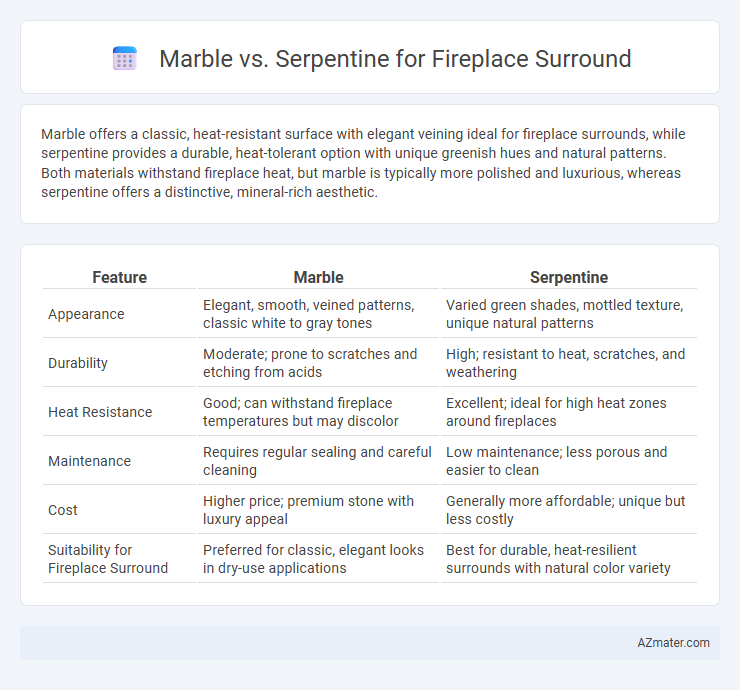Marble offers a classic, heat-resistant surface with elegant veining ideal for fireplace surrounds, while serpentine provides a durable, heat-tolerant option with unique greenish hues and natural patterns. Both materials withstand fireplace heat, but marble is typically more polished and luxurious, whereas serpentine offers a distinctive, mineral-rich aesthetic.
Table of Comparison
| Feature | Marble | Serpentine |
|---|---|---|
| Appearance | Elegant, smooth, veined patterns, classic white to gray tones | Varied green shades, mottled texture, unique natural patterns |
| Durability | Moderate; prone to scratches and etching from acids | High; resistant to heat, scratches, and weathering |
| Heat Resistance | Good; can withstand fireplace temperatures but may discolor | Excellent; ideal for high heat zones around fireplaces |
| Maintenance | Requires regular sealing and careful cleaning | Low maintenance; less porous and easier to clean |
| Cost | Higher price; premium stone with luxury appeal | Generally more affordable; unique but less costly |
| Suitability for Fireplace Surround | Preferred for classic, elegant looks in dry-use applications | Best for durable, heat-resilient surrounds with natural color variety |
Introduction to Marble and Serpentine Fireplaces
Marble fireplaces offer a timeless elegance with their smooth texture and wide range of color variations, making them a popular choice for classic and modern interiors. Serpentine fireplaces feature a unique, rich green hue with striking patterns, providing a natural and distinctive aesthetic that stands out in any room. Both materials are durable and heat-resistant, ensuring long-lasting beauty and functionality for fireplace surrounds.
Aesthetic Differences: Veining, Color, and Style
Marble fireplace surrounds exhibit striking, bold veining with a range of colors from pure white to deep greens and blacks, creating a classic, luxurious aesthetic that complements both traditional and modern interiors. Serpentine features softer, more subtle veining with predominantly green hues and occasional brown or yellow tones, offering an earthy, unique style well-suited for rustic or contemporary designs. The choice between marble and serpentine hinges on the desired visual impact, with marble emphasizing dramatic contrasts and serpentine providing a more muted, natural look.
Heat Resistance and Fireplace Safety
Marble offers moderate heat resistance, making it suitable for fireplace surrounds but requiring careful maintenance to prevent cracking under extreme heat fluctuations. Serpentine, known for higher heat tolerance and durability, provides enhanced fireplace safety by withstanding prolonged exposure to high temperatures without degrading. Choosing serpentine over marble reduces risks of thermal shock and structural damage, ensuring long-term fireplace performance and safety.
Durability and Scratch Resistance Comparison
Marble and serpentine both offer unique advantages for fireplace surrounds, with marble known for its elegant appearance but softer composition, making it more prone to scratches and etching over time. Serpentine, particularly the variety known as green marble, exhibits higher durability and better scratch resistance due to its magnesium-rich composition and harder mineral structure. For long-term performance, serpentine is often preferred in high-traffic or frequently used hearths because it maintains its finish and structural integrity more effectively than marble.
Maintenance Requirements: Cleaning and Sealing
Marble fireplace surrounds require regular sealing every 6 to 12 months to prevent staining and etching from soot and cleaning agents, while serpentine is more resistant to acids and fewer seals are needed. Cleaning marble demands gentle, pH-neutral cleaners to avoid surface damage, whereas serpentine tolerates mild detergents and less frequent cleaning due to its inherent durability. Both materials benefit from immediate spill cleanup but serpentine's lower porosity reduces maintenance frequency, making it a practical choice for busy households.
Cost Analysis: Installation and Long-Term Value
Marble fireplace surrounds typically cost between $50 to $150 per square foot for materials and installation, offering a luxurious appearance but requiring regular maintenance to prevent staining and etching. Serpentine, priced around $40 to $90 per square foot, provides a more affordable alternative with unique veining patterns, benefiting from higher durability and resistance to heat-related damage. Over the long term, marble may incur higher upkeep expenses, while serpentine's lower maintenance and strong durability contribute to better overall value for fireplace surrounds.
Environmental Impact and Sustainability
Marble fireplace surrounds typically have a higher environmental impact due to intensive quarrying processes and significant energy consumption during extraction and transport. Serpentine, often sourced with lower emissions and less waste, offers a more sustainable option as it requires less energy to process and has higher durability, reducing the need for frequent replacement. Choosing serpentine supports eco-friendly practices while maintaining aesthetic appeal and functional longevity in fireplace design.
Design Versatility and Customization Options
Marble offers exceptional design versatility for fireplace surrounds with its wide range of colors, veining patterns, and finishes, allowing for both classic and contemporary aesthetics. Serpentine stone, while less varied in appearance, provides unique greenish hues and smooth texture that can add a distinctive, natural elegance to fireplace designs. Customization options for marble include intricate carvings and polished or honed finishes, whereas serpentine is often favored for simple, sleek profiles due to its softer composition limiting detailed work.
Popular Trends: Modern vs Classic Looks
Marble offers a sleek, polished finish that complements modern fireplace surrounds with its smooth texture and subtle veining, making it a popular choice for contemporary interior designs. Serpentine, known for its rich green hues and unique mottled patterns, lends itself to classic, traditional aesthetics that highlight earthy elegance and timeless charm. Increasingly, homeowners blend marble's clean lines with serpentine's natural warmth to achieve a balanced fireplace surround that bridges modern minimalism and classic sophistication.
Final Verdict: Choosing the Right Stone for Your Fireplace
Marble offers a luxurious, timeless appearance with its smooth texture and wide range of colors, making it ideal for elegant fireplace surrounds that withstand moderate heat. Serpentine provides a unique, mottled aesthetic with natural green hues, delivering better heat resistance and durability for high-use fireplaces. Choosing the right stone depends on balancing aesthetic preferences with practical considerations like heat tolerance and maintenance requirements.

Infographic: Marble vs Serpentine for Fireplace Surround
 azmater.com
azmater.com